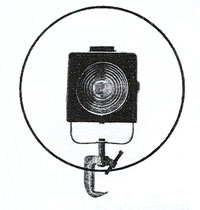

BY TOM SKELTON
courtesy of
Dance Magazine
first published
March 1956
TOOLS OF LIGHTING DESIGN: LIGHTING A MODERN DANCE
On Broadway the lighting designer usually has from one to several hundred spotlights to work with, and all the dimmers he needs. A touring dance company often performs in a theatre that has only one or two spotlights and no dimmers. Obviously the same lighting design will not fit both types of theatres, so when I design lighting I think of it in terms of the “Basic 15 Spotlights” which are diagrammed in Part III of this series. (Dec. issue: p. 63) Then it is possible to maintain a design concept that is sufficiently flexible to utilize more spotlights when they are available, or to keep a performance with minimum equipment from looking shabby and undersigned.
When you go to the first rehearsal with the purpose of designing the lighting, it is best to see the first run-through of the composition just as an audience will see it; that is, without advance information from the choreographer as to the content. Then 1) analyze the stage areas the dancers use (it is for this reason that I have discussed, also in December, “dance areas”; 2) the quality and focus of the movement (to know which angles of light will best emphasize it); the costume colors (to know what colors of gelatine to use in the spotlights); 3)the movement climaxes and the dramatic transitions and developments (to know where the light should change to emphasize development); 4) and the times relationships of the curtain, music and beginning and ending of the dance (to establish those cues). This thorough analysis may require you to see many rehearsals before you are able to discuss your ideas with the choreographer. Although such an analysis at first sounds formidable, experience will help you master this basic approach.
Let us take, for our study examples, a modern dance, a jazz lament and a pas de deux. This month we start with a work by the well-known concert and television performer, Mary Anthony. The Peter Basch photos on these pages of Mary Anthony in “…the wind…” are an example of simple side lighting from spotlights mounted about 8’ high on standards in the wings. Note the way side lighting gives highlights and permits the audience to see the movement clearly.
I. A Modern Dance
Mary Anthony’s solo “…the wind…” subtitled (“imagine you are a house around which I am the wind”), is from a poem by e. e. cummings which is narrated as the curtain opens. She is standing UC with her back to the audience and slowly starts to turn her body right and left (illus. #1) peering to the center of the stage.
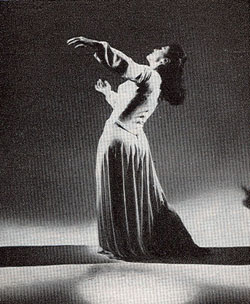
#1
Several sharp movements indicate that the dance is dramatic as well as lyrical, and by the end of the narration the theme of the dance is established. The dancer now starts a series of big turns that take her to UR and DR, where she does several extensions of the arms and legs (illus. #2), facing center, and starts to cross the stage in the down plane, with turns and extensions that keep her body either full front or full back to the audience, never in profile.
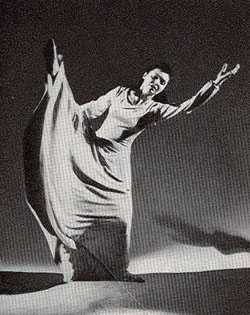
#2
When she reaches DL she again turns to face the center of the stage and her body assumes an attitude of pain and agony (illus. #3).
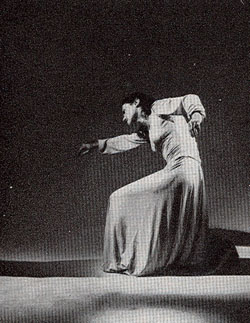
#3
By now I have come to realize that the “house” of the narration is the center of the stage, and that the movement of the dancer covers only the area outside the house. The open lyric style of the movement indicates that she is the “wind” outside the house, but it is punctuated by dramatic gesture that shows that something inside the house is motivating the action. She is more than the wind blowing around a house, she is the outsider who doesn’t belong, or she is the woman rejected by her lover, or she is the mother watching the child whose growing pains she cannot ease, or anything the imagination cares to associate with the dance.
After defining the flat walls of the house, she moves to UR and again turns to face the center of the stage, looking between her parallel arms as though looking through a window (illus. #4).
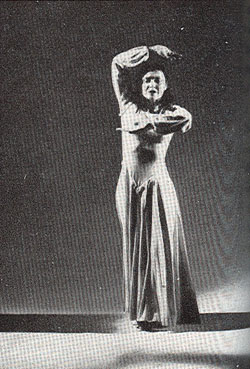
#4
This movement theme develops into sweeping, protective turns around the house (illus. #5).
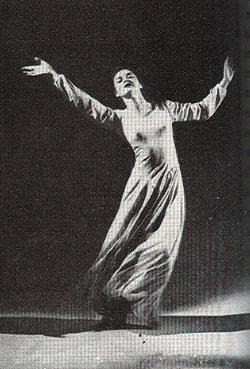
#5
The dance ends as she returns to her original position UR and the movement returns to the slow body turns (illus. #6).
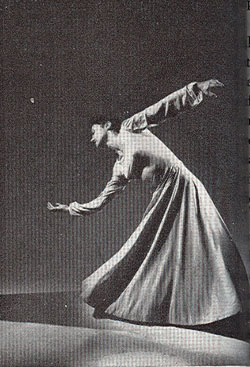
#6
Now what about lighting? Should it become blue when she is sad and pink when she is happy? No, the changes would be too distracting. Nor is the lighting as simple as “make a house in the center of the stage,” for if it was Miss Anthony would have a piece of scenery for the house. The lighting can, however, help her immediately to get across the idea that the center of the stage is an area she does not use, that much of her movement is designed to delineate the center area, and that the UC spot where she begins is not significant in itself (as the porch of a house might be) but rather that she wanted to begin and end in the same spot to show that the cycle had completed itself and that she arbitrarily chose UC.
It would be wrong to delineate the “house area” too sharply as a square, for then it would be a literal house, not the abstract area of her imagination. It would also be wrong to start with only a special spotlight on her and them dimming up the “house area” as she starts to draw the walls in her movement, for that would establish a false relationship between her opening position and the house.
Since the most important movements are in relation to the center of the stage, a spotlight hanging on the center of the second light pipe focused straight down with an amber gelatine, to represent interior lighting. Could define the “house area.” Since the angle is straight down and since she does not enter this area, the spotlight will not provide any actual illumination for her except that which is reflected from the floor. The three spotlights on stage right that make up the right wash (refer back to Part III) and the three spotlights on stage left that make up the left wash can provide illumination for the entire stage. These spotlights are mounted on standards about 8 feet high (between the medium side and high side angles illustrated in February’s article) and since they provide lighting from both sides her body will have good form to emphasize the movement and her face will have adequate visibility to satisfy those in the audience who watch the face more than they watch the movement.
The costume is white, so Steel Blue would be a good color for the side washes since it will make the costume whiter than white. It is a color that is cold, like the wind, and further emphasizes the feeling that she is shut out, and it will offer sufficient contrast to the amber down light so that the side of the dancer’s body that is facing center stage will always have a warm glow. With Steel Blue coming down from the sides and Amber coming straight down from above, we also further emphasize the isolation of the center area.
I don’t think that there should be any lighting changes during this dance, but the lights should slowly fade in and out at the beginning and end to point up the fact that the theme has neither beginning nor ending but is merely a section of the cycle of life. Changes would distract the audience from the emphasis the lighting is trying to make: that the center area is different than the rest of the stage.
The ideal background for this dance would be a flat sky drop without any light on it. The only light it would receive would be reflected light from the floor, so it would appear a dark gray. If it were lit, it might imply sky or it might limit the space feeling of the choreography. A black drapery would also be unfortunate since it would provide too much contrast to the white costume and give the lyrical movement a sharp. Etched quality.
This design concept uses only seven of the “Basic 15 Spotlights.” If, in a specific theatre, Miss Anthony had only two spotlights available, I would suggest that they be placed DR and DL and focused on the right diagonal and left diagonal (see illustration in Part III) with Steel Blue gelatins, and that she go to any hardware store or 5 and 10¢ store where, for a little more than a dollar, she could buy one of the pre-focus “reflector lamps” (PAR 38 or R-40) used so often in display lighting for the center light. Those come in 75 or 150-watt sizes with either a flood or spot focus. Many of these lamps come pre-colored, or you can buy a special clip-on device to hold a colored-glass filter. But color would not be absolutely necessary for the center light in this case, and a white bulb could be used instead, since the dancer does not actually enter the “house area” of white light (which is so unflattering to skin and costume colors), and because, with Steel Blue used in the spotlights, white light would appear amber by contrast. The bulb would then simply have to be screwed into a standard household socket and suspended over the “house area.” If dimmers are not available, the same effect of “no beginning, no ending” could be achieved by having the curtain open as the movement starts and close on the last movement so that it is closed by the end of the movement.
(cont. in April)
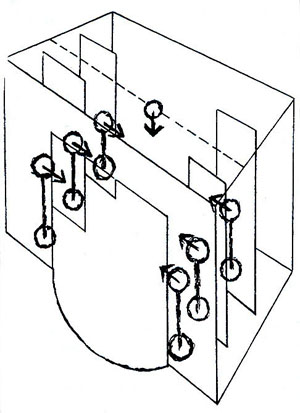
Distribution of lights for the dance described in the article above.